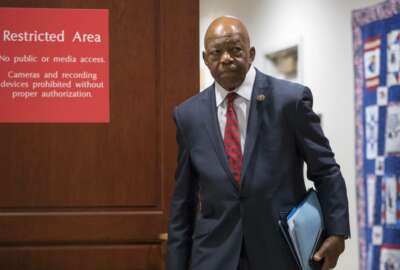

The Trump administration says a recent Supreme Court case decision is prompting the White House to change the current hiring process for administrative law judges.

A recent Supreme Court decision is prompting the Trump administration to change the long-held hiring and appointment process for administrative law judges (ALJs).
Under a new executive order, which President Donald Trump signed Tuesday, agency heads will now directly appoint and hire administrative law judges using a new service “Schedule E.”
Agencies will no longer have to use a typical competitive hiring process to appoint most other federal employees. The order eliminates the current examination procedures for new ALJs, which the Office of Personnel Management currently oversees and administers.
“This process gives agency heads a greater flexibility and responsibility for ALJ appointments and is very, very similar to the process under which federal attorneys are currently hired,” James Sherk, special assistant to the president for domestic policy, told reporters Tuesday afternoon.
The creation of a new schedule essentially moves ALJs from the competitive service to political appointees.
On Tuesday Trump also issued a separate executive order that lets the U.S. Marshals Service directly hire certain deputy U.S. marshals and criminal investigators without using competitive service procedures.
Currently, OPM administers an ALJ examination to interested candidates. OPM will place those who have the required legal experience and pass a series of online and in-person exams, interviews and other assessments on a list of qualified candidates. OPM uses that register to refer three candidates to a particular agency for consideration.
The existing process meant that agencies generally had to choose from a limited pool of candidates, and they only hire new ALJs on OPM’s schedule.
Now, the executive order simply requires that ALJ candidates must have an active bar license or must be an active judge, but agencies can set their own qualifications and criteria for selecting new judges.
The Trump administration says a recent Supreme Court case, Lucia v. Securities and Exchange Commission, inspired the new EO.
In that case, the court ruled that ALJs are considered “inferior officers,” meaning only the president or agency heads have the authority to appoint them to federal office under the appointments clause of the U.S. Constitution.
Citing the appointments clause, Justice Elena Kagan ruled that the Securities and Exchange Commission improperly appointed an administrative law judge, and that judge’s decisions are subject to review.
Sherk said the June 21 case raised questions about the process SEC specifically used to appoint ALJs but the decision had the potential to implicate others agencies as well.
“The agency is going to have to retry the entire case before a properly appointed ALJ, so you have potentially hundreds or more cases that have to be redone across the government,” he said. “This legal uncertainty as to whether or not the ALJ has handed down a binding ruling, which they can only do if they’re properly appointed, could hinder the enforcement of many different laws that are enforced by many different agencies across the federal government.”
The White House has already heard about “hundreds of cases” at other agencies besides the SEC, where lawyers are questioning the proper appointment of an ALJ involved in a particular ruling, Sherk said.
“This is something we’re already seeing in many places, and we’re trying to basically give the agencies greater certainty and reduce the litigation risks that they might have,” he said.
Though the Trump administration says the court decision prompted the appointment change for ALJs, Tuesday’s executive order, in a sense, represents a growing trend to abandon the traditional and seemingly outdated federal hiring process in favor of a direct, targeted solution for a specific occupation.
ALJs serve as independent arbiters for benefits agencies, such as the Social Security Administration and the Health and Human Services Department.
SSA, which has roughly 1,600 ALJs and hires the most of any other agency, has struggled to quickly attract and hire enough judges to meet demand.
The Government Accountability Office in 2010 recommended that OPM review and consider other options for the ALJ hiring process.
OPM will issue guidance to agencies on how they should transition from the current ALJ appointment process to the new schedule.
“By reducing legal uncertainty surrounding ALJ appointments and improving the efficiency of the process, the order will help agencies more effectively enforce laws that protect the American people. This change addresses potential constitutional concerns with the ALJ appointment process without affecting ALJ’s decisional independence after they are appointed,” OPM Director Jeff Pon said Tuesday in a statement. “It’s a change that has been necessary for quite some time.”
Trump’s executive order does not address the process for removing ALJs, nor does it affect the appointment of current judges, Sherk said.
Copyright © 2024 Federal News Network. All rights reserved. This website is not intended for users located within the European Economic Area.
Nicole Ogrysko is a reporter for Federal News Network focusing on the federal workforce and federal pay and benefits.
Follow @nogryskoWFED


